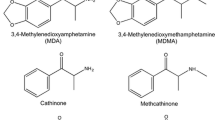Abstract
This study tested structural analogs of phencyclidine (PCP) using drug discrimination procedures to determine which analogs produced discriminable effects similar to those of PCP. It also tested the utility of multiple-drug discrimination training (PCP versus other drugs or saline) as a method for increasing the specificity produced by training. All discrimination training took place in two-lever operant compartments using FR-10 reinforcement of presses on the correct lever. During training, rats were required to concurrently discriminate PCP from one or more other drug conditions. Rats in group 1 discriminated PCP (lever 1) versus saline (lever 2). Rats in group 2 discriminated PCP (lever 1) versus saline, fentanyl, phenobarbital, amphetamine, or mescaline (lever 2). In both groups 1 and 2, the required discriminations were rapidly learned. The percentage of PCP choices and the ED50 doses obtained during tests for generalization did not differ significantly in groups 1 and 2. Drugs to which responding on the PCP lever generalized included 1-[1-(2-thienyl)cyclohexyl]piperidine, N-3thyl-1-phenylcyclohexylamine, 1-phenylcyclohexylamine, ketamine, 1-(1-phenylcyclohexyl)morpholine, 1-[1-(2-thienyl)cyclohexyl]morpholine, N,N-diethyl-1-phenylcyclohexylamine, N-(iso-propyl)-1-phenylcyclo-hexylamine, N-methyl-1-phenylcyclohexylamine, N-(n-propyl)-1-phenylcyclohexylamine, Dextrorphan, (dl)-N-allyl-N-normetazocine, N-N-dimethyl-1-phenylcyclo-hexylamine N-(n-butyl)-1-phenylcyclohexylamine, 1-[1-(2-thienyl)cyclohexyl]pyrrolidine, and N-(s-butyl)-1-phenylcyclohexylamine, in agreement with previous reports. Rats in group 3 discriminated PCP (lever 1) versus saline, cyclazocine, dextrorphan, phenobarbital, or mescaline (lever 2). this discrimination was learned slowly, and asymptotic accuracy was low, thus demonstrating one of the limitations of drug discrimination training paradigms that require the concurrent discrimination of several drugs.
Similar content being viewed by others
References
Holtzman SG (1980) Phencyclidine-like discriminative stimulus properties of opioids in the rat. J Pharmacol Exp Ther 214:614–619.
Holtzman SG (1982) Phencyclidine-like discriminative stimulus properties of opioids in the squirrel monkey. Psychopharmacology 77:295–300.
Overton DA (1982) Multiple drug training as a method for increasing the specificity of the drug discrimination procedure. J Pharmacol Exp Ther 221:166–172.
Shannon HE (1981) Evaluation of phencyclidine analogs on the basis of their discriminative stimulus properties in the rat. J Pharmacol Exp Ther 216:543–551.
Shannon HE (1983) Discriminative effects of phencyclidine: structure activity relationships. In: Kamenka JM, Domino EF, Geneste P (eds) Phencyclidine and related arylcyclohexylamines: present and future applications. NPP Books, Ann Arbor, Michigan, pp 311–335.
Snapper AG, Kadden RM (1970) Time-sharing in a small computer based on a behavioral notation system. In: Weiss B (ed) Digital computers in the behavioral laboratory. Appleton-Century-Croft, New York, pp 41–97.
Solomon RE, Herling S, Domino EF, Woods JH (1982) Discriminative stimulus effects of N-substituted analogs of phencyclidine in rhesus monkeys. Neuropharmacology 21:1329–1336.
White JM, Holtzman SG (1983) Three-choice drug discrimination: phencyclidine-like stimulus effects of opioids. Psychopharmacology 80:1–9.
Zukin SR, Brady KT, Slifer BL, Balster RL (1984) Behavioral and biochemical stereoselectivity of sigma opiate/PCP receptors. Brain Res 294:174–177.
Author information
Authors and Affiliations
Rights and permissions
About this article
Cite this article
Overton, D.A., Shen, C.F., Ke, G.Y. et al. Discriminable effects of phencyclidine analogs evaluated by multiple drug (PCP versus other) discrimination training. Psychopharmacology 97, 514–520 (1989). https://doi.org/10.1007/BF00439557
Received:
Accepted:
Issue Date:
DOI: https://doi.org/10.1007/BF00439557




